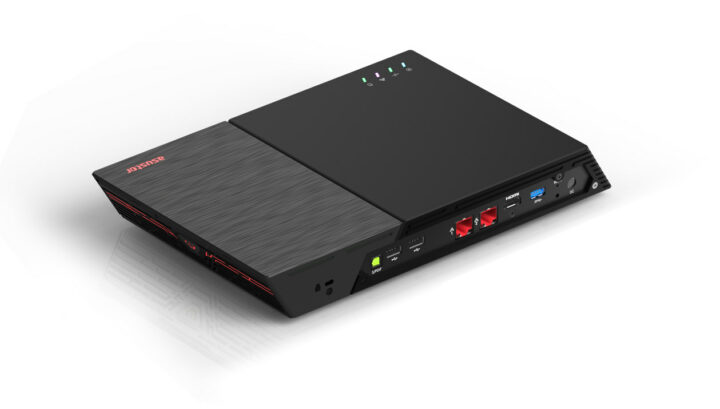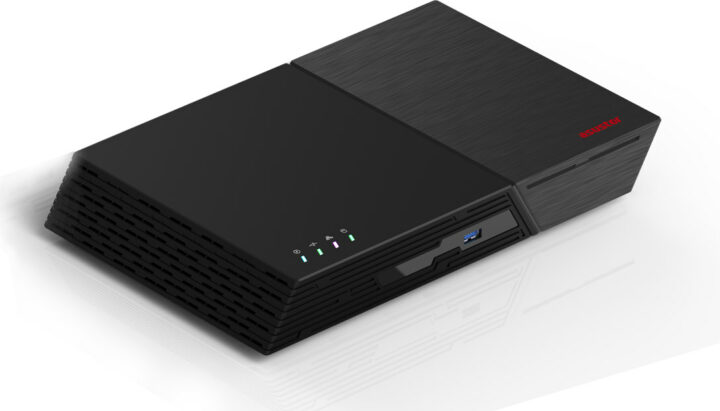ASUSTOR FLASHSTOR 6 and FLASHSTOR 12 are network access storage (NAS) devices powered by a quad-core Intel Celeron N5095 Jasper Lake processor and designed for respectively 4K audio and video content consumption for the former and 4K video editing for the latter.
Both models come with 4 GB of DDR4-2933, two USB 3.2 Gen 2×1 ports, and HDMI 2.0b video output, but the FLASHSTOR 6 supports up to 6 M.2 NVMe SSDs and 2.5GbE networking, while the FLASHSTOR 12 can take up to 12 M.2 NVMe SSDs and handles 10GbE networking.
ASUSTOR FLASHSTOR specifications:
- SoC – Intel Celeron N5105 quad-core Jasper Lake processor @ 2.0 GHz / 2.9 GHz (Turbo)
- System Memory – 4GB SO-DIMM DDR4, expandable up to 16GB via 2x SO-DIMM slots
- Storage
- 8GB eMMC flash for the OS
- FLASHSTOR 6 (FS6706T) – 6x M.2 2280 NVMe drive slots, up to 14x drives with AS6004U expansion unit for HDD/SSD
- FLASHSTOR 6 (FS6712X) – 12x M.2 2280 NVMe drive slots, up to 20x drives with AS6004U expansion unit for HDD/SSD
- Networking
- FLASHSTOR 6 (FS6706T) – 2x 2.5GbE RJ45 ports (2.5G/1G/100M)
- FLASHSTOR 6 (FS6712X) – 1x 10GbE port (10G/5G/2.5G/1G/100M)
- Video and audio outputs – 1x HDMI 2.0b, 1x S/PDIF
- USB – 2x USB 3.2 Gen 2×1 (10 Gbps), 2 x USB 2.0
- Misc – 80mm system fan (Noise Level: 18.7dB)
- Power Supply – FS6706T: 65W; FS6712X: 90W
- Power Consumption
- Operation – FS6706T: 18.2W; FS6712X: 26W
- Sleep mode – 0.83W
- Dimensions – 308.26 x 193 x 48.3 mm
- Weight – About 1.35 kg
- Temperature Range – 0°C~40°C
- Humidity – 5% to 95% RH
- Certifications – FCC, CE, VCCI, BSMI, C-TICK, KCC, BIS, CCC, UKCA
The NAS devices support a wide range of software features such as the ASUSTOR Portal (HDMI Local Output), Cloud Backup Center, DataSync Center for Google Drive, OneDrive, Dropbox, etc.. sync, LooksGood smart video manager with transcoding capabilities, and many others. The internal drives are formatted with EXT4 or Btrfs, while the external drives support FAT32, NTFS, EXT3, EXT4, HFS+, exFAT, or Btrfs. Supported operating systems include Windows XP to 11, Windows Server 2003 to 2022, macOS, UNIX, Linux, and BSD.
It’s not the first time we write about NAS with NVMe SSDs, as QNAP launched the TBS-464 ultra-thin NAS with support for up to four M.2 NVMe SSDs and 2.5GbE networking in 2021, and followed up with the TBS-574X NAS taking hot-swappable E1.S SSDs last year.
The FLASHSTOR 6 and 12 can be purchased on Amazon for $499.00 and $799.00 respectively. Further details may be found on the product page.
Thanks to TLS for the tip.

Jean-Luc started CNX Software in 2010 as a part-time endeavor, before quitting his job as a software engineering manager, and starting to write daily news, and reviews full time later in 2011.
Support CNX Software! Donate via cryptocurrencies, become a Patron on Patreon, or purchase goods on Amazon or Aliexpress. We also use affiliate links in articles to earn commissions if you make a purchase after clicking on those links.






Thank you for the site much love …but not the weirdo kind
Beautiful!
But what OS is running on it? Some NAS OS by Asustor, I presume?
Supported operating systems include Windows XP to 11, Windows Server 2003 to 2022, macOS, UNIX, Linux, and BSD.
Yeah, they have their own custom NAS OS. just like their competitors.
Overpriced junk. Cheaper to build your own imo with freeNas scale or proxmox + freenas core as a VM and direct passthrough using pci-e cards. There is no way there is enough pci-e lanes to take advantage of the performance
Please let us know how you fit 12 NVMe SDDs into a custom build with the same form factor. I’d honestly want to know.
Yes, this thing is gimped, but it’s still impossible to DIY something in this form factor.
As others have stated, considering the one with 6 slots only has a 2.5Gbps network connection the max speeds you would get is 250MB/s which you can get with spinning drives. While the 12 slot one has a 10Gbps network connection that would still max out at 1GB/s regardless of the RAID configuration you use so you would never get the roughly 3 to 4 GB/s throughput for sequential read/writes at large block sizes which are misleading because random read/writes at smaller block sizes are what is most important because that’s typically what’s used more. Maybe not for video editing where you have large files but this would need a 40Gbps network connection to even come close to getting full throughput for sequential read/writes at large block sizes.
While these devices are neat from a technical standpoint they are kind of useless in real world scenarios as you can achieve close to the same speeds with a spinning drive NAS, especially if it only has a 2.5Gbps NIC and not a 10Gbps NIC. You might even be able to get full throughput with a 10Gbps NIC if you live dangerously and run a RAID 0 configuration.
People tend to focus on those speeds when doing a speed test but random is more important because that’s what you are going to get mostly outside transferring say, one 50GB file to an external TB4 or USB4 drive if connected directly to a PC or laptop.
I agree that random speed is way more important for a NAS and that’s precisely where such devices can be interesting, because random access on a spinning rust is terrible. You don’t care about saturating the ethernet here, what matters is that you can achieve very low latency accesses while almost constantly achieving wire-speed. Would I buy that ? No, and surely not at this price! But really there are valid use cases to SSD-based NAS.
They should have choosen a platform which can actually take advantage of that SSDs. The N5105 just don’t have enough PCIe lanes for that. There is only 8 lanes from the PCH, which you probably need to use 2 for Ethernet and it likely shares bandwidth with the USB ports that come from the PCH and not straight CPU.
The big advantage that I see is that it’s really small but you aren’t really getting that much out of the SSDs vs several HDDs.
also, a device like this would probably benefit greatly from high dwpd ssd like the micron 7400 pro, which has recently become quite affordable. unfortunately, the higher capacity variants are not m2.2280, but m2.22110.
> There is only 8 lanes from the PCH, which you probably need to use 2 for Ethernet
And this is the bottleneck for the whole device (it’s a NAS) anyway so it really doesn’t matter what happens behind the other PCIe lanes, PCIe switch and USB ports since the network is always the limiting factor…
It’s an SoC, so no PCH with a narrow bus in the way. But yes, no native Ethernet, so all the PCIe lanes are being used up.
As pointed out below, the Ethernet interface is still the biggest bottleneck.
> It’s an SoC, so no PCH with a narrow bus in the way
According to Intel datasheets those Jasper Lake SoCs consist of CPU and PCH (even made in different processes), see ‘Platform Block Diagram‘.
Intel generally doesn’t make SoCs as tkaiser pointed out, they generally put the PCH in the same package as the CPU for the mobiles variants. If you google Tiger Lake die, you will see both dies in the same package, with the smaller being the CPU and then a big PCH.
I couldn’t find the width of the PCH <-> CPU link(DMI) but it really can be x4 or x8. Either way, a lot of peripherals share it with the PCIe lanes, stuff like USB, which could have a big impact if used at full tilt.
In anycase, yes the Ethernet is the bottleneck, but really then, why bother with expensive NVMe SSDs(and not even the cheaper SATAs one) when you really can’t use those to it’s full advantage? Keeping in mind that even 6 HDDs will saturate 10 GbE
> Keeping in mind that even 6 HDDs will saturate 10 GbE
There are (NAS) use cases where sequential transfer speed don’t matter that much but random I/O is important (e.g. doing incremental backups). With SSDs regardless of protocol used a RAID-6/RAIDz2 will perform great unlike with spinning rust. And yes, SATA SSDs would’ve been fine too but they’re about to become ‘legacy tech’ soon and are not always cheaper.
I wish I could find an ATX board with that many M.2 slots. I built a 6x2TB NVMe NAS a couple years ago and it’s working great but since I’m using client class hardware (alderlake) I ran out of PCIe lanes to expand it later. Hopefully more bifurcation support for next gen systems is coming otherwise some day I’m going to need bigger drives 😀